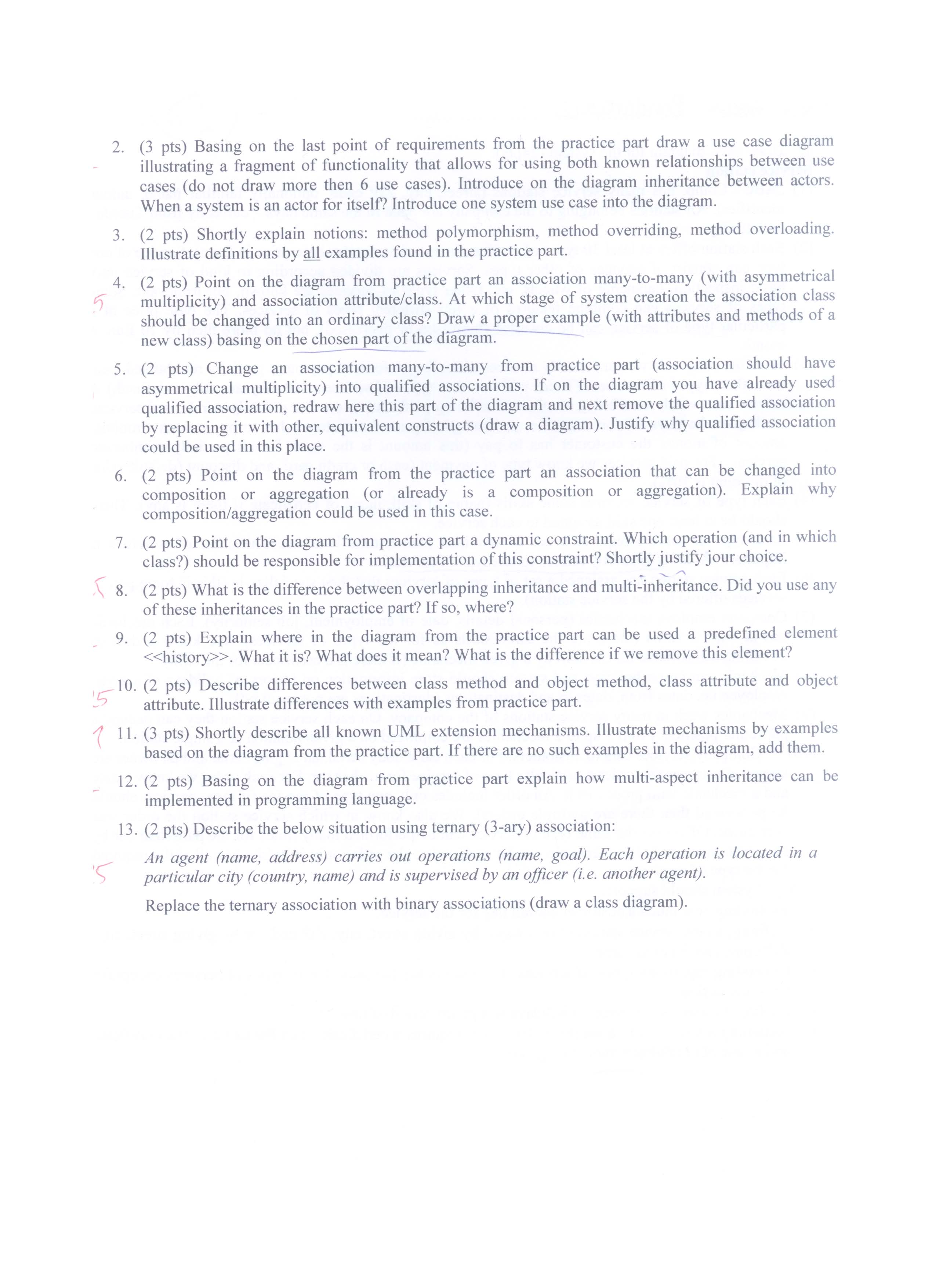PRI k2 06 kozankiewicz v1 2

2. (3 pts) Basing on the last point of reąuirements from the practice part draw a use case diagram illustrating a fragment of functionality that allows for using both known relationships between use cases (do not draw morę then 6 use cases). Introduce on the diagram inheritance between actors. When a system is an actor for itself? Introduce one system use case into the diagram.
3. (2 pts) Shortly explain notions: method polymorphism, method overriding, method overloading. Illustrate definitions by ąh examples found in the practice part.
4. (2 pts) Point on the diagram from practice part an association many-to-many (with asymmetrical multiplicity) and association attribute/class. At which stage of system creation the association class should be changed into an ordinary class? Draw a proper example (with attributes and methods of a new class) basing on the chosen part of the diagram.
5. (2 pts) Change an association many-to-many from practice part (association should have asymmetrical multiplicity) into qualified associations. If on the diagram you have already used qualified association, redraw here this part of the diagram and next remove the qualified association by replacing it with other, equivalent constructs (draw a diagram). Justify why qualified association could be used in this place.
6. (2 pts) Point on the diagram from the practice part an association that can be changed into composition or aggregation (or already is a composition or aggregation). Explain why composition/aggregation could be used in this case.
7. (2 pts) Point on the diagram from practice part a dynamie constraint. Which operation (and in which class?) should be responsible for implementation of this constraint? Shortly justify jour choice.
\ 8. (2 pts) What is the difference between overlapping inheritance and multi-inheritance. Did you use any of these inheritances in the practice part? If so, where?
9. (2 pts) Explain where in the diagram from the practice part can be used a predefmed element «history». What it is? What does it mean? What is the difference if we remove this element?
L*r
10. (2 pts) Describe differences between class method and object method, class attribute and object attribute. Illustrate differences with examples from practice part.
•’ 11. (3 pts) Shortly describe all known UML extension mechanisms. Illustrate mechanisms by examples based on the diagram from the practice part. If there are no such examples in the diagram, add them.
12. (2 pts) Basing on the diagram from practice part explain how multi-aspect inheritance can be implemented in programming language.
13. (2 pts) Describe the below situation using ternary (3-ary) association:
An agent (name, address) carries out operations (name, goal). Each operation is located in a particular city (country, name) and is supervised by an officer (i. e. another agent).
Replace the ternary association with binary associations (draw a class diagram).
Wyszukiwarka
Podobne podstrony:
PRI k2 06 kozankiewicz v4 2 2. (3 pts) Basing on the last point of requirements from the practice pa
PRI k2 06 kozankiewicz v3 2 o 2- A 4. 5. (9 D O 9. V (3 pts) Basing on the last point of requirement
PRI k1 06 kozankiewicz v1 2 i z 2. (3 pts) Define UML notions: actor, use case, in
PRI k2 06 kozankiewicz v1 5 r (M -4^ CflbU Ł- rt (WGm OtWf ^qt fikCiu^U, ipo<Wc
PRI k2 06 kozankiewicz v1 6 io£ ■ CJ2 4Wi & q> Q6jif.^K <XA Isecdu je £jxd-1 je<ru o? C
PRI k2 06 kozankiewicz v1 7 ^jl>t~ bz-un* ! e>n- -J c (/
PRI k2 06 kozankiewicz v1 1 Name 1. Draw class diagram for the system (24pts): Service station (1) &
PRI k2 06 kozankiewicz v1 3 Przedmiot oceny Zakres ocen Waga Ocena 1. Poprawność (suma ocen z punkt
PRI k1 06 kozankiewicz v1 1 TEST 1 (20
więcej podobnych podstron